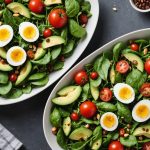Salads often get a bad rap. Many people associate them with bland diets that leave them feeling hungry. However, with the right ingredients and preparation methods, salads can be both satisfying and nutritious. This article aims to guide you in crafting delicious salads that not only keep you feeling full but also support your goal of staying slim. Whether you’re a salad novice or an experienced enthusiast, this guide will provide you with practical tips and creative ideas to enhance your salad-making skills.
Understanding the Components of a Filling Salad
To create a salad that satisfies your hunger, it is essential to understand its core components. A well-rounded salad typically includes a variety of textures and flavors, which contribute to both taste and fullness.
Also to read : What are the best practices for reading food labels to choose healthier options?
Start with a base, usually leafy greens like spinach, kale, or romaine. These greens are low in calories and provide essential vitamins and minerals, making them an excellent foundation for your salad. Next, add protein-rich ingredients. Proteins such as grilled chicken, chickpeas, tofu, or hard-boiled eggs not only boost the nutritional value of your salad but also help to keep you satisfied for longer periods.
Incorporating healthy fats is another critical aspect. Ingredients like avocado, nuts, or seeds not only add flavor but also slow down digestion, which contributes to a feeling of fullness. Finally, don’t forget to introduce a variety of vegetables. Bell peppers, cucumbers, carrots, and tomatoes can add crunch and color, making your salad visually appealing and enjoyable to eat.
Also read : How can I create a meal plan that emphasizes whole foods for weight management?
When crafting your salad, think about balance. Aim for a mix of greens, proteins, fats, and vegetables, creating a harmonious dish that delights the palate while keeping you satiated.
Creative Ingredients to Elevate Your Salads
Using a diverse range of ingredients in your salads can significantly enhance their satisfaction level. Creativity is crucial here, as it allows you to experiment with different tastes and textures.
Consider incorporating grains like quinoa, brown rice, or farro. These whole grains add substance and help to keep your energy levels stable. Not only do they provide essential nutrients, but they also create a hearty salad that can stand as a meal on its own.
Moreover, think about adding roasted vegetables. Roasting brings out the natural sweetness in veggies like sweet potatoes, Brussels sprouts, and zucchini. This simple cooking method adds depth to your salad, making it more enjoyable and filling.
Don’t shy away from fruits either. Ingredients like apples, berries, or even citrus segments can introduce a refreshing contrast in flavor. The natural sugars from fruits can also satisfy your sweet cravings without resorting to unhealthy options.
Finally, consider your choice of dressing. Opt for homemade dressings using olive oil, vinegar, and fresh herbs. Homemade options allow you to control the ingredients, ensuring they are wholesome and not laden with preservatives. A well-balanced dressing can tie all your ingredients together, enhancing the overall taste and satisfaction of your salad.
Mastering Salad Preparation Techniques
Preparation is key when it comes to assembling a satisfying salad. The way you chop, mix, and serve your ingredients can greatly impact your overall enjoyment and fullness.
Start by washing your greens thoroughly. Clean, crisp greens not only taste better but also contribute to a more refreshing eating experience. Consider tearing the leaves instead of chopping them. This method can help retain their structure and create a more appealing texture.
Next, focus on the layering of ingredients. Instead of tossing everything in a bowl, layer your ingredients strategically. Place the base greens on the bottom, followed by proteins, grains, and then top it off with veggies and fruits. This approach allows for an even distribution of flavors with each bite, enhancing satisfaction.
Another crucial aspect is the timing of your salad preparation. Prepare your salad just before serving. This helps maintain the freshness of the ingredients, especially for items like avocado and tomatoes, which can brown or wilt quickly. If you’re meal prepping, consider storing each component separately and combining them just before eating.
Remember to engage your senses during preparation. A visually pleasing arrangement can make your salad more appealing, while vibrant colors can stimulate your appetite. Always take your time to make your salad not just a meal, but an experience.
Salad Pairings and Portions for Optimal Satisfaction
Pairing your salad with the right accompaniments can enhance its satisfaction factor. While salads can be a meal on their own, they can also be complemented with additional foods to create a more filling experience.
If you’re looking to enjoy your salad as a standalone meal, consider portion sizes carefully. A good rule of thumb is to fill half your plate with salad. This portion should include a generous amount of greens, proteins, and other ingredients. This not only contributes to a balanced diet but also ensures you feel full after eating.
When pairing your salad, think about adding a side of whole-grain bread or a serving of fruit. These options complement your meal without overwhelming it. If you enjoy a warm dish, consider pairing your salad with a light soup. The warmth of the soup can contrast nicely with the cold ingredients of your salad, creating a satisfying combination.
For those looking to snack, salads can also be transformed into a nutritious side dish. Pair a smaller portion of salad with lean meats, fish, or even plant-based proteins. This allows you to enjoy the freshness of the salad while still receiving the necessary nutrients from your main dish.
The key is to listen to your body’s hunger cues. If you feel satisfied, you likely have created a well-rounded meal. If you’re still hungry, consider adding more protein or healthy fats to your salad, adjusting the components as needed.
Crafting satisfying salads that keep you full and slim is not just about the ingredients; it’s about understanding the balance of nutrition and flavor. By focusing on a variety of components, exploring creative ingredients, mastering preparation techniques, and considering portion sizes, you can create salads that are both enjoyable and fulfilling. Embrace the versatility of salads as a culinary canvas, and remember this powerful dish can be tailored to fit any diet or personal preference. With these tips, you are not just eating a salad; you are savoring a meal that nourishes both your body and mind.











